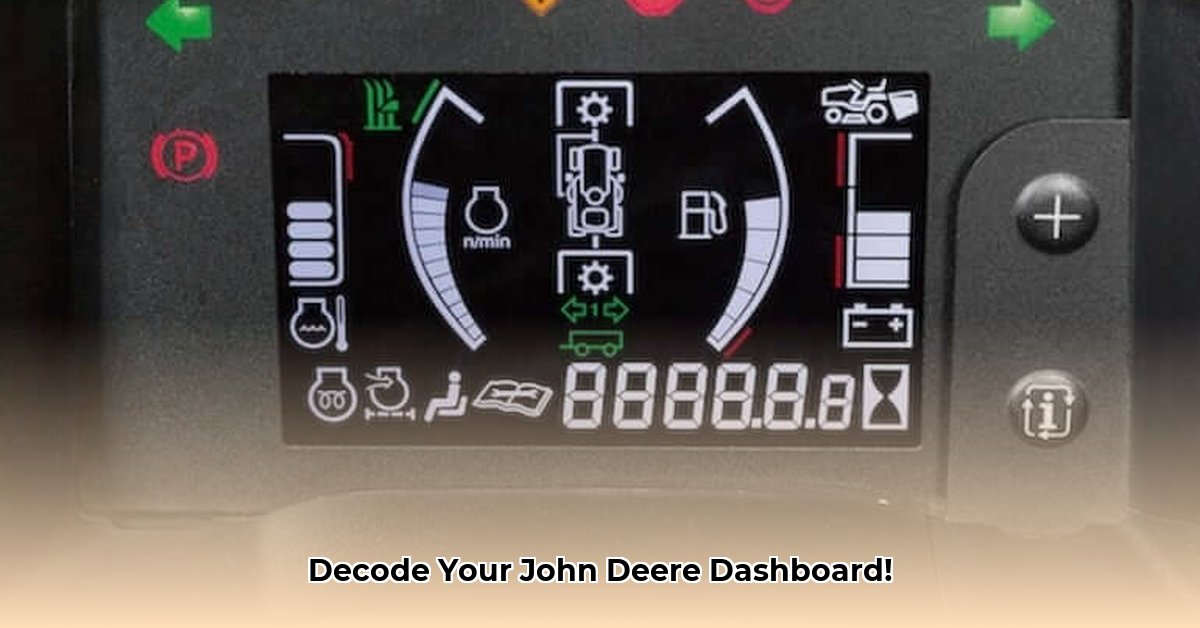
Understanding Your John Deere Tractor Dashboard: A Comprehensive Guide
Navigating the array of lights and symbols on your John Deere tractor's dashboard can feel daunting, but mastering this crucial interface is key to safe and efficient operation. This guide provides a step-by-step approach to understanding your tractor's dashboard, enabling you to quickly identify and address potential problems. We'll decode the color-coded warnings, explore common symbols, and offer practical troubleshooting tips. By the end, you'll be a dashboard expert! For more detailed symbol explanations, see this helpful resource: John Deere Tractor Symbols.
Decoding the Color Code: Your Tractor's Warning System
John Deere employs a straightforward color-coding system for dashboard warnings. Understanding this system is the first step towards proactive maintenance:
Red (Critical): Signals an immediate and serious problem requiring immediate attention. Ignoring a red warning light could lead to significant damage or injury. Stop the tractor immediately.
Amber/Yellow (Caution): Indicates a potential issue that merits prompt attention, though not necessarily an immediate shutdown. Address these warnings as soon as is practical.
Green/Blue (Operational Information): Generally signals normal operation. These lights usually provide information rather than warnings.
Common Dashboard Symbols: A Quick Reference
While specific symbols may vary slightly depending on the tractor model, several are common across the John Deere range. Always consult your owner's manual for precise details and model-specific information. This guide provides a general overview.
Engine Temperature (Thermometer Symbol): Rising temperature, especially into the red zone, signals overheating. Immediately shut down the engine and allow it to cool before further investigation.
Oil Pressure (Oil Can Symbol): A low oil pressure reading is critical. Oil lubricates engine components; low pressure risks catastrophic engine failure. Stop immediately and check oil levels.
Fuel Level (Fuel Gauge): Indicates the remaining fuel in the tank. Monitor to avoid running out of fuel in the field.
Battery (Battery Symbol): A glowing battery symbol indicates a problem with the electrical system, possibly low charge, a faulty alternator, or other electrical issues.
Transmission Warnings (Transmission Symbol): Indicates potential transmission issues, such as overheating or hydraulic problems.
Hydraulic System Indicators (Hydraulic Symbol): Show potential problems with hydraulic pressure or fluid levels. Low hydraulic fluid can severely limit functionality.
Brake System Warnings (Brake Symbol): Never ignore brake system warnings. Immediate attention is critical for safety.
Implement Warnings (Varying Symbols): These symbols relate to attached implements (plows, mowers, etc.) and will vary depending on the equipment.
Beyond the Basics: Understanding More Complex Warnings
Many John Deere tractors incorporate advanced monitoring systems, resulting in a broader range of dashboard symbols. These may include additional warnings for things like:
Differential Lock: Indicates the status of your differential lock, essential for traction in challenging conditions.
Parking Brake: Shows whether the parking brake is engaged.
4WD Engagement: Indicates whether your four-wheel drive is activated.
PTO (Power Take-Off) Engagement: Shows if the PTO is engaged – a critical safety consideration.
Always refer to your owner's manual for a comprehensive list of symbols and their meanings specific to your tractor model.
Becoming a Dashboard Detective: Practical Troubleshooting Steps
Proactive monitoring of your dashboard is crucial for preventing major issues. Here's a systematic approach to troubleshooting warning lights:
Identify the Warning: Note the color (red, amber, green, or blue) and the symbol.
Consult Your Owner's Manual: The owner's manual provides detailed explanations and recommended actions for each symbol.
Visual Inspection: After identifying the warning, visually inspect the related system. Check fluid levels, connections, belts, and hoses.
Basic Checks: Perform simple checks such as fluid levels (oil, coolant, hydraulic fluid).
Advanced Diagnostics (If Necessary): If basic checks don't reveal the issue, more advanced diagnostic tools may be needed.
Professional Assistance: If you’re unsure or unable to resolve the problem, contact a qualified John Deere mechanic. Don't attempt repairs beyond your skill level.
Preventative Maintenance: Your Best Defense
Regular preventative maintenance is essential for minimizing the risk of warnings. Scheduled servicing helps catch minor issues before they escalate into major problems. Regularly inspect fluid levels, check belts and hoses, and ensure components are functioning correctly.
Key takeaway: Proactive dashboard monitoring, coupled with regular maintenance, significantly improves tractor longevity and safety. Always prioritize safety and consult your owner's manual and a qualified technician when needed.